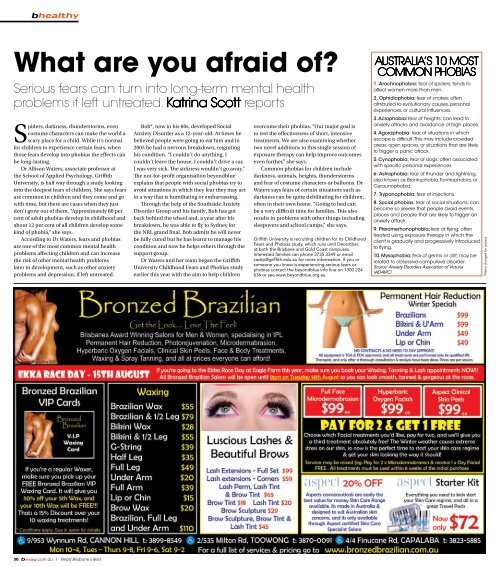BEST - Bmag
BEST - Bmag
BEST - Bmag
Create successful ePaper yourself
Turn your PDF publications into a flip-book with our unique Google optimized e-Paper software.
healthy<br />
What are you afraid of?<br />
Serious fears can turn into long-term mental health<br />
problems if left untreated. Katrina Scott reports<br />
Spiders, darkness, thunderstorms, even<br />
costume characters can make the world a<br />
scary place for a child. While it’s normal<br />
for children to experience certain fears, when<br />
those fears develop into phobias the effects can<br />
be long-lasting.<br />
Dr Allison Waters, associate professor at<br />
the School of Applied Psychology, Griffith<br />
University, is half way through a study looking<br />
into the deepest fears of children. She says fears<br />
are common in children and they come and go<br />
with time, but there are cases when they just<br />
don’t grow out of them. “Approximately 80 per<br />
cent of adult phobias develop in childhood and<br />
about 12 per cent of all children develop some<br />
kind of phobia,” she says.<br />
According to Dr Waters, fears and phobias<br />
are one of the most common mental health<br />
problems affecting children and can increase<br />
the risk of other mental health problems<br />
later in development, such as other anxiety<br />
problems and depression, if left untreated.<br />
30 bmag.com.au I Read Brisbane’s Best<br />
Bob*, now in his 60s, developed Social<br />
Anxiety Disorder as a 12-year-old. At times he<br />
believed people were going to eat him and in<br />
2005 he had a nervous breakdown, reigniting<br />
his condition. “I couldn’t do anything, I<br />
couldn’t leave the house, I couldn’t drive a car,<br />
I was very sick. The sickness wouldn’t go away.”<br />
The not-for-profit organisation beyondblue<br />
explains that people with social phobias try to<br />
avoid situations in which they fear they may act<br />
in a way that is humiliating or embarrassing.<br />
Through the help of the Southside Anxiety<br />
Disorder Group and his family, Bob has got<br />
back behind the wheel and, a year after his<br />
breakdown, he was able to fly to Sydney for<br />
the NRL grand final. Bob admits he will never<br />
be fully cured but he has learnt to manage his<br />
condition and now he helps others through the<br />
support group.<br />
Dr Waters and her team began the Griffith<br />
University Childhood Fears and Phobias study<br />
earlier this year with the aim to help children<br />
overcome their phobias. “Our major goal is<br />
to test the effectiveness of short, intensive<br />
treatments. We are also examining whether<br />
two novel additions to this single session of<br />
exposure therapy can help improve outcomes<br />
even further,” she says.<br />
Common phobias for children include<br />
darkness, animals, heights, thunderstorms<br />
and fear of costume characters or balloons. Dr<br />
Waters says fears of certain situations such as<br />
darkness can be quite debilitating for children,<br />
often in their own home. “Going to bed can<br />
be a very difficult time for families. This also<br />
results in problems with other things including<br />
sleepovers and school camps,” she says.<br />
Griffith University is recruiting children for its Childhood<br />
Fears and Phobias study, which runs until December,<br />
at both the Brisbane and Gold Coast campuses.<br />
Interested families can phone 3735 3349 or email<br />
cadrp@griffith.edu.au for more information. If you or<br />
someone you know is experiencing serious fears or<br />
phobias contact the beyondblue info line on 1300 224<br />
636 or see www.beyondblue.org.au.<br />
AUSTRALIA’S 10 moST<br />
common phobIAS<br />
1. Arachnophobia: fear of spiders; tends to<br />
affect women more than men.<br />
2. Ophidiophobia: fear of snakes; often<br />
attributed to evolutionary causes, personal<br />
experiences, or cultural influences.<br />
3. Acrophobia: fear of heights; can lead to<br />
anxiety attacks and avoidance of high places.<br />
4. Agoraphobia: fear of situations in which<br />
escape is difficult. This may include crowded<br />
areas, open spaces, or situations that are likely<br />
to trigger a panic attack.<br />
5. Cynophobia: fear of dogs; often associated<br />
with specific personal experiences.<br />
6. Astraphobia: fear of thunder and lightning,<br />
also known as Brontophobia, Tonitrophobia, or<br />
Ceraunophobia.<br />
7. Trypanophobia: fear of injections.<br />
8. Social phobias: fear of social situations; can<br />
become so severe that people avoid events,<br />
places and people that are likely to trigger an<br />
anxiety attack.<br />
9. Pteromerhanophobia: fear of flying; often<br />
treated using exposure therapy in which the<br />
client is gradually and progressively introduced<br />
to flying.<br />
10. Mysophobia: fear of germs or dirt; may be<br />
related to obsessive-compulsive disorder.<br />
Source: Anxiety Disorders Association of Victoria<br />
(ADAVIC)<br />
*Name changed for privacy











